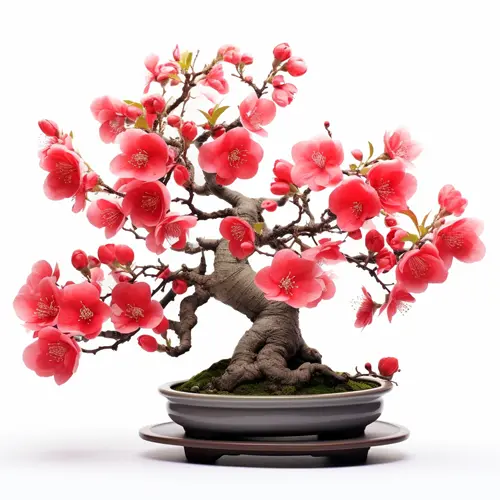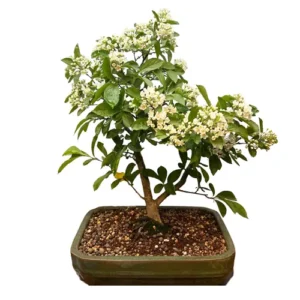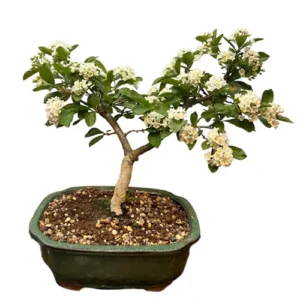Chaenomeles japonica
Flowering Quince Bonsai
Appearing at the opening of the year, the Flowering Quince is adorned with glossy leaves before blooming red, white and pink flowers in the spring. Producing multiple stems, these little trees can produce beautiful little yellow and red fruits from their foliage. Native to the woodlands around the Japanese mountains.

Flowering Quince Bonsai Care Tips
Placement
Choose an outdoor location that can provide full sun. Flowering Quince bonsai trees are hardy in temperate regions and don’t require specific winter protections. However, if you expect significant frosts below, consider moving it to an unheated greenhouse, conservatory or providing insulation for the pot.
Watering
Throughout the growing season, Flowering Quince require watering regularly and don’t be afraid to mist except when fruiting or flowering. Come winter, water sparsely only to ensure the soil stays moist.
Feeding & Fertilising
Feed the Flowering Quince every fortnight after the plant has finished flowering, using a fertilizer with a high nitrogen content. Keep this regimen till leaves fall. From mid into late summer consider using a fertiliser with a lower nitrogen content.
Pruning & Wiring
Old growths should be pruned back immediately after flowering. This should include trimming new shoots and twigs to maintain shape. Careful to not prune too vigorously after mid-summer as this could affect the shoots to come next year. New shoot tips can be pinched out as and when, but avoid doing so from the late summer.
The Flowering Quince has no wiring requirements. Shaping should be achieved through pruning.
Repotting
Repotting your tree is an important way to provide a fresh and suitable soil mix and ensure appropriate root health. Flowering Quince requires repotting every 2-3 years immediately after flowering in the early spring. It is possible to repot in late autumn in temperate regions like the UK but this will demand frost protection for the plant come winter.
Trees that are ready for repotting will require root pruning, a suitable new pot and appropriate soil mix.
When repotting, do not cut back the root mass by a large amount, and choose a well-draining soil mix that has a neutral or slightly higher PH value of 5-6 but not over 7. We tend to use a mixture of different speciality bonsai soils on our trees. Every species is different so please contact us for free soil-mix advice or to take advantage of our repotting service.
Bonsai trees aren’t only magnificent additions to an indoor oasis, they are more than capable of standing out in any garden. Many Bonsai species are incredibly hardy and withstand nature’s colder and damper turns with aplomb making them worthwhile outdoor plants. We have an extensive library of care guides for outdoor bonsai trees. It’s not about selecting the perfect bonsai, it’s about selecting the perfect bonsai for you.
Flowering Quince Bonsai - Typical Queries
Can Flowering Quince Bonsai be kept indoors?
No, a Flowering Quince Bonsai is not suitable for indoor cultivation. It needs full sun exposure and cold winter dormancy to thrive and flower. It should be placed outdoors in a sunny spot and protected from frost and strong winds.
Are Flowering Quince Bonsai hardy?
Yes, a Flowering Quince Bonsai is a hardy plant that can tolerate a wide range of temperatures and climates. However, it is sensitive to overwatering and root rot, so it should be planted in a well-drained soil and watered carefully. It is also prone to pests and diseases, such as aphids, scale, and fire blight, so it should be inspected regularly and treated accordingly.
When does a Flowering Quince Bonsai bloom?
A Flowering Quince Bonsai usually blooms in late winter or early spring, before the leaves emerge. The flowers last for several weeks and can range from pink, red, or white in color. The flowers are followed by small green fruits that ripen in autumn and can be eaten or used for jams and jellies.
Is Flowering Quince toxic to pets?
Flowering Quince is not outright toxic but does require some vigilance. The fruit it bears is edible but not raw, it requires cooking or bletting. The pulp is non-toxic but its seeds have traces of poison, if eaten in substantial quantities could be toxic. However, Chaenomeles Japonica fruit is substantially hard and is not known to be toxic to household pets.





















